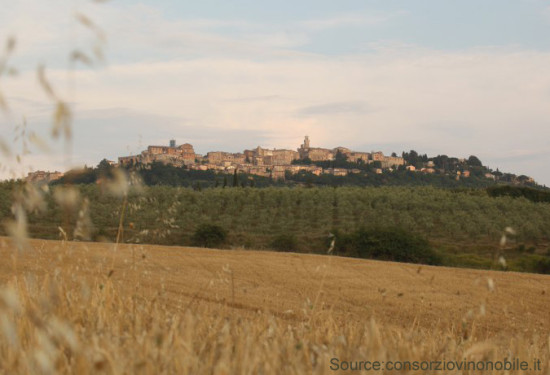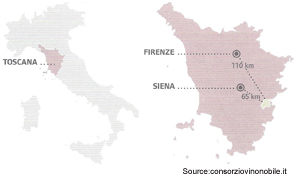 Montepulciano is home to the Vin Nobile di Montepulciano wines. Montepulciano is a hill town located in the province of Sienna in southern Tuscany. The town is located within the Chianti Colli Senesi sub-zone.
Montepulciano is home to the Vin Nobile di Montepulciano wines. Montepulciano is a hill town located in the province of Sienna in southern Tuscany. The town is located within the Chianti Colli Senesi sub-zone.

In 1966 Vino Nobile di Montepulciano was awarded Denominazione de origine Controllata (DOC) status and continued its upward journey in quality and was awarded Denominazione di origine Controllata e Garantita (DOCG) status in 1980.
Traceability
Each bottle notes this with a neck strip with the letters DOCG. This neck strip also contains a serial number and other marking that can be entered in on the website http://www.consorziovinonobile.it/104-43/ENG/TRACEABILITY
This will provide information about the quantities of bottles produced in that batch, some basic analytical information (alcohol content, dry extract and total acidity) and information about the producer.
Grape Varieties and the Wines
The main grape varietal for the red wine that is grown here is Sangiovese but is known as Prugnolo Gentile in Montepulciano. The majority of the wines produced here are the Vin Nobile di Montepulciano, Vin Nobile di Montepulciano Reserva and Vinsanto.
The Vin Nobile di Montepulciano and the Rosso di Montepulciano wines consist of at least 70 % of Prugnolo Gentile and a maximum 30% of other red grapes approved to be grown in Tuscany.
The Vin Nobile di Montepulciano has ageing requirements of at least 24 months before release and the Riserva has a36 mothns ageing period. The Rosso di Montepulciano is a young wine released no sooner than March 1 of the year following the harvest.
Vin Santo di Montepulciano and Vin Santo do Montepulciano are only allowed to be made with Malvasia Bianca, Grechetto Bianco, Trebbiano Toscano for the minimum 70 % part. The maximum of 30% can consist of other white varieties that are allowed in the Tuscany region.
Vin Santo di Montepulciano Occhio di Pernice must have a minimum of 50% of Prugnolo Gentile and the balance can be other grapes allowed to grown in the Tuscany region.
Climate
The climate is a mix of continental with influences from the Adriatic Sea. The vineyards are planted up on the hill side providng the vines with warmer days and cooler nights.
Soils
The soils are diverse but to generalize they can be considered to contain more clay and less rocks.
Vin Nobile Flavor Profile
In general, without any significant oak influences, the flavor profile consists of ripe red fruits, medium body, firm tannins and with the natural high acidity of sangiovese.
The Laws of the DOCG for Vin Nobile di Montepulciano
With the Consorzio del Vino Nobile Di Montepulciano, the Ministry of Agriculture issued a decree creating the laws of quality controls and production for the Vin Nobile wines. These laws dictate the production area, the grapes, ageing requirements, bottling requirements and the characteristics expected from a Vin Nobile wine. The Consorzio del Vino Nobile di Montepulciano has translated into English and summarized these laws and are as follows.
Vin Nobile di Montepulciano
The law: The first production regulations were drawn up on July 12 1966.In 1980 Vino Nobile di Montepulciano was granted the Denominazione di Origine Controllata e Garantita, and was the first wine to be released with the top classification recognised by Italian legislation.
The most recent modifications were approved by decree on November 9th 2010.
PRODUCTION ZONE: The territory of the commune of Montepulciano excluding the area of the Valdichiana, and limited to vineyards situated between 250 and 600 metres above sea level.
THE GRAPES: Sangiovese, called “Prugnolo Gentile” in Montepulciano, minimum 70% may be joined up to 30% by other varieties authorized for the Tuscany Region.
YIELDS: The maximum yield of grapes per hectare is 8 tons.
AGEING: Vinification and compulsory ageing must take place within the territory of the commune of Montepulciano. Wine with the appellation Vino Nobile di Montepulciano DOCG must undergo an ageing period of at least two years, starting from January 1st following the harvest. Within this period producers may choose from the following options:
1) 24 months of maturation in wood
2) 18 months minimum maturation in wood and the remaining months in other ageing vessels.
3) 12 months minimum in wood and six months minimum in bottle and the remaining months in other ageing vessels. In the second and third cases, the beginning of wood ageing must not be after April 30 of the year following the harvest.
Wine with the appellation Vino Nobile di Montepulciano DOCG cannot be released before the end of the two years maturation prescribed by law, with the starting date being January 1st of the year following the grape harvest.
BOTTLING: Bottling operations must take place within the vinification zone.
Wine with the appellation Vino Nobile di Montepulciano DOCG which does not qualify as riserva may be bottled in the entire territory of the region of Tuscany by cellars which have been bottling Vino Nobile di Montepulciano DOCG for at least three years before the present production regulations came into effect.
RISERVA : Wine with the appellation Vino Nobile di Montepulciano DOCG deriving from grapes with a minimum natural alcoholic content by volume of 12.50% and subjected to an ageing period of at least 3 years of which six months must be in bottle, may have the added qualification riserva on the label, with the minimum time to be spent in wood as stipulated.
CHARACTERISTICS:
Minimum total alcoholic strength by volume: 12.50%, for the Riserva 13.00%
Minimum total acidity: 4.5 g/l
Minimum net dry extract: 23 g/l.
Rosso di Montepulciano
The law
DOC production regulations approved by presidential decree on December 21st 1988 and subsequent modifications as prescribed by decree on November 9th 2010.
PRODUCTION ZONE: The territory of the commune of Montepulciano excluding the area of the Valdichiana, and limited to vineyards situated between 250 and 600 metres above sea level.
THE GRAPES: Sangiovese, called “Prugnolo Gentile” in Montepulciano, minimum 70% may be joined up to 30% by other varieties authorized for the Tuscany Region.
YIELDS: The maximum permitted yield of grapes for the production of “Rosso di Montepulciano” DOC is 10 tons per hectare of specialized vineyard.
AGEING: “Rosso di Montepulciano” DOC may not be released before March 1st
of the year following the grape harvest. Within sixteen months from January 1st following the harvest, wine qualified for the appellation “Vino Nobile di Montepulciano” DOCG, may be re-classified as “Rosso di Montepulciano” DOC as long as it fulfils the conditions and requirements laid down by the production regulations.
CHARACTERISTICS:
Minimum total alcoholic strength by volume: 11.50%
minimum total acidity: 4.5 g/l
minimum net dry extract: 21 g/l
The law: DOC production regulations approved by G.U. Serie generale n.269 on November 16th 1996 and subsequent modifications as prescribed by decree on November 9th 2010.
PRODUCTION ZONE: The production zone of the DOC wines “Vin Santo di Montepulciano”, ”Vin Santo di Montepulciano” Riserva and “Vin Santo di Montepulciano” Occhio di Pernice, covers the territory of the commune of Montepulciano excluding the low-lying area of the Valdichiana.
THE GRAPES: “Vin Santo di Montepulciano”and ”Vin Santo di Montepulciano” Riserva: Malvasia bianca, Grechetto bianco (locally known as Pulcinculo), Trebbiano Toscano, either singly or together, for a minimum of 70%. A maximum of 30% of other white varieties may be included on condition that they are authorized to be cultivated within the Tuscan Region.Aromatic varieties may not be included. “Vin Santo di Montepulciano”
Occhio di Pernice: Sangiovese (Prugnolo Gentile) minimum 50%; other varieties recommended or authorized to be cultivated within the Tuscan Region, either singly or together, up to a maximum of 50%.
AGEING: Vinification, storing, and compulsory ageing of the wines must take place within the territory of the commune of Montepulciano. Bottling must take place within the province of Siena. The maximum permitted yield of the grapes in wine at the end of the ageing period must not exceed 35% of the fresh grapes Traditional vinification is carried out as follows: The grapes must be carefully selected at harvest-time and laid out to dry in suitable premises; partial drying-out with ventilation is permitted, and the sugar content after the drying process must reach 28% for the “Vin Santo di Montepulciano” DOC and at least 33% for the “Vin Santo di Montepulciano” Riserva DOC and the “Vin Santo di Montepulciano” Occhio di Pernice DOC. The grapes must not be crushed before: December 1st following the harvest for the “Vin Santo di Montepulciano; January 1st of the year following the harvest for “Vin Santo di Montepulciano” Riserva and “Vin Santo di Montepulciano” Occhio di Pernice. Storing and ageing must take place in wooden vessels not exceeding a capacity of 300 litres for “Vin Santo di Montepulciano”, in casks not exceeding a capacity of 125 litres for “Vin Santo di Montepulciano” Riserva, and in casks not exceeding a capacity of 75 litres for the “Vin Santo di Montepulciano” Occhio di Pernice. The minimum ageing period in wood is three years for “Vin Santo di Montepulciano”, five years for “Vin Santo di Montepulciano” Riserva, and six years for “Vin Santo di Montepulciano” Occhio di Pernice.
CHARACTERISTICS:
“Vin Santo di Montepulciano”
Minimum total alcoholic strength by volume: 17% of which at least 2% is unconverted;
minimum dry extract excluding sugars: 20 g/l.
minimum total acidity: 4.5 g/l
volatile acidity: a maximum of 40 mEq/l
“Vin Santo di Montepulciano” Riserva”
Minimum total alcoholic strength by volume 20% of which at least 3.5%;
minimum dry extract excluding sugars: 22 g/l
minimum total acidity: 4.5 g/l
volatile acidity: a maximum of 40 mEq/l.
“Vin Santo di Montepulciano” Occhio di Pernice”
Minimum total alcoholic strength by volume 21% of which at least 4%;
minimum dry extract excluding sugars: 25 g/l
minimum total acidity: 4.5 g/l
volatile acidity: a maximum of 40 mEq/l.
The “Vin Santo di Montepulciano” D.O.C., for all its typologies, must have a minimum alcoholic strength of 12% vol.
